
Day 1
BeijingInternational flight on your own arrangement. Once arrive in Beijing,be met and transferred to your hotel. Feel free at leisure for the rest of the day.
Day 2
Beijing-
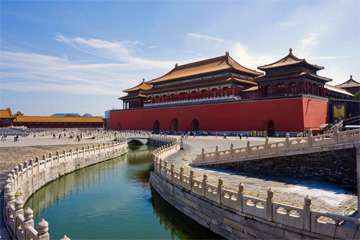
- The Tian anmen Square
After breakfast starts with a visit to the Temple of Heaven .You will see local people practicing Tai Chi,as well as singing and calligraphy in the neighboring park,and take a leisurely walk through Tiananmen Square to the Forbidden City, enjoy the panoramic view of Forbidden City form Jing-shan Hill .Sample Peking Duck Dinner before a fantastic Kongfu Show .
The Tian'anmen Square : The largest city square in the world.
The Forbidden City : The largest imperial palace in China during the Ming and Qing dynasties with a history of around 600 years.Located in the middle of Beijing, Forbidden City was the Chinese royal palace from the Ming Dynasty to the end of the Qing Dynasty. Also called Palace Museum, the Forbidden City is recognized as the most magnificent and splendid palace complex in China and one of the five world-famous palaces with the Palace of Versailles in France, Buckingham Palace in England, the White House in United States and the Kremlin in Russia.
The Temple of Heaven : Temple of Heaven ( Tiantan ) is located in the southern part of Beijing, and has been one of the most holy places for the whole country for more than five centuries. It used as a complex of sacrificial buildings for the Ming and Qing emperors, and is the largest one in Beijing among several royal altars to Heaven, Earth, the Sun, the Moon and other deities or symbolic forces of Nature.
Day 3
Beijing-
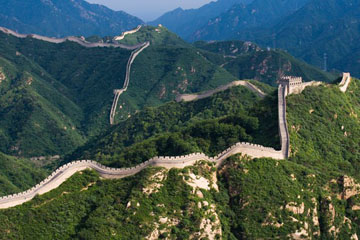
- The Great Wall
Morning head to visit the Great Wall, Ming Tomb .Then explore the alleyway -"Hutong" by riding on a traditional rickshaw to catch close-up glimpses of local life.
The Great Wall : One of the seven wonders in the world and the symbol of China.Badaling Great Wall is the most impressive and the most visited section of the Great Wall of China. Constructed in 1502 during the Ming Dynasty, the Badaling Great Wall once served as an important military fortification. Many leaders from China and around the world, like Richard Nixon, Margaret Thatcher…all visited this section of the wall.
The Ming Tomb : The only underground tomb of the thirteen tombs of the emperors in the Ming Dynasty.Some 50 kilometers northwest of the downtown Beijing, the Ming Tombs are generally combined with a visit to the Great Wall. Otherwise known as the “13 Tombs”, this is the burial site of 13 out of 17 emperors of the Ming Dynasty. However, the only one you can get a good look at is the tomb of Emperor Wanli, who reigned from 1537 to 1620. This tomb was unearthed in 1956. There are two others that have been uncovered, but the rest remain illusive.
Day 4
Beijing-
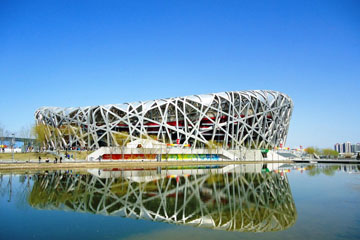
- the Bird's Nest National Stadium
Take a photo stop at the 200 Olympic Site to see the Bird's Nest National Stadium and Water Cube Aquatic Centre .Then explore the Summer Palace-a former imperial summer resort.
Bird's Nest National Stadium:The National Stadium, affectionately known as Bird's Nest, is situated in Olympic Green Village, Chaoyang District, Beijing. It was designed as the main stadium of 2008 Beijing Olympic Games. The Olympic events of track and field, football, gavelock, weight throw and discus were held there. Since October, 2008, after the Olympics ended, the National Stadium has been opened as a tourist attraction. Now, it's the center of international or domestic sports competition and recreation activities .
Water Cube Aquatic Centre:Located on the west side of Landscape Avenue in the Olympic Green and to the west of Beijing National Stadium(Bird's Nest), the National Aquatics Center contains the official 2008 Olympics swimming facility. It measures 177 meters (194 yards) long, 177meters wide, and 30 meters (98 feet) high and covers an area of 62,950 sq meters (75,287 sq yard). It has four floors: one at street level, two above, and one below. Its floor space reaches 79,532 sq meters (95,119 sq yard), while the below street level area is no less than 15,000 sq meters (17,939 sq yard). The one below served as the service area during the Olympics. The first floor is for tourists. The auditorium is on the second floor with 6,000 fixed seats (2,000 of which are movable), and 11,000 temporary seats. The third floor is strictly for business .
Summer Place:Situated in the Haidian District northwest of Beijing City, the Summer Palace is 15 kilometers (9.3 miles) from central Beijing. Being the largest and most well-preserved royal park in China, it greatly influences Chinese horticulture and landscape with its famous natural views and cultural interests, which also has long since been recognized as 'The Museum of Royal Gardens' .
Day 5
Beijing-

- Yungang Caves
Take the morning train ride to the ancient city of Datong.Visit Yungang Caves,where to see amazing Buddhist carving craftsmanship from thumb-sized figurines to a 12m Buddhist statues,and then visit the 1500 year old Hanging Monastery with its halls and pavilions built along the natural contours of the cliff.
Yungang Caves:one of the three major cave clusters in China, punctuate the north cliff of Wuzhou Mountain, Datong. The area was excavated along the mountain, extending 1 km (0.62 miles) from east to west, revealing 53 caves and over 51,000 stone statues.The Caves are divided into east, middle, and west parts. Pagodas dominate the eastern parts; west caves are small and mid-sized with niches. Caves in the middle are made up of front and back chambers with Buddha statues in the center. Embossing covers walls and ceilings.
Hanging Monastery :Hanging Monastery stands at the foot of Mt. Hengshan, 5 kilometers (3 miles) south of Hunyuan County, and 65 kilometers (40 miles) from downtown Datong City. Since it hangs on the west cliff of Jinxia Gorge more than 50 meters above the ground, it is called Hanging Monastery.Hanging Monastery, built in 491, has survived more than 1400 years. The extant monastery was largely rebuilt and maintained in the Ming Dynasty (1368-1644) and Qing Dynasty (1644-1911)
Day 6
Datong-

- Qiao-Family-Courtyard-House
After breakfast head to the World Heritage listed ancient town of Pingyao-where to see the city surrounded by Ming City Walls .You will find yourself flung back in time as your eyes behold the Tang Dynasty fortress.watchtower,cast iron,intimidating wooden gates and sturdy walls.Pingyao was China's banking centra and has many mansions,courtyard house,temples,museums and historic shops.Stroll from Ming Qing street to Town Tower,Armed Escort Company Museum and the Temple of the City God.Visit Qiao Family Courtyard House,where the movies "Raise the Red Lantern" was filmed.Take an overnight soft sleeper train to Xi'an.
Temple of the City God:As one of the best preserved temples in China, the Temple of the City God is located in the southeast of Pingyao City. The whole construction is of a grand scale, and covers an area of 7,302 square meters (approx. 8,733 square yards). The temple has a long history and has been renovated several times.Built facing the south, the temple looks very magnificent.
Qiao Family Courtyard House:The prosperity of the Qiao Family originated with Qiao Guifa who was an orphan and made a living as a servant during the reign of Emperor Qianlong (1711 - 1799) in the Qing Dynasty (1644 - 1911). He first started a business when he met his business partner, Qin. Initially, they sold fodder, bean sprout and bean curd. Several years later, they had become very wealthy.
Day 7
Xi'an-
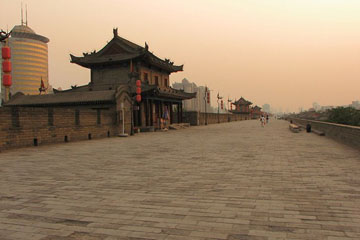
- The Ancient City Wall
Morning arrive Xi'an,you will be met and transferred to your hotel.This afternoon stroll on the original City Wall,Which you have opportunity to cycle on this ancient wall,and then explore the Old Muslim Quarter and Old Mosque.Tonight enjoy a local specialty-dumpling dinner before the famous Tang Dynasty culture show.
The Ancient City Wall : An extension of the old Tang Dynasty structure boasting the most complete city wall that survives through Chinese long history.The City Wall has corner towers, ramparts, sentry towers, gate towers, battlements and a a number of city defensive fortifications with very strong defense capability.
Old Muslim Quarter and Old Mosque:The Great Mosque is a Chinese traditional Alhambresque architecture with a long history and grant scale, which is the great combination of Islamic and Chinese culture. It was recorded that it was established in the first year of the Tian Bao reign by Li Lung Ji, after renovations and expansions on several occasions in the Song, Yuan and especially the Ming and Qing Dynasties, it gradually takes on the current performance. The Great Mosque and the Muslim Quarter now is the important relic preservation of Shanxi Province and the national important relic preservation of third period.
Day 8
Xi'an-

- The Terra-cotta Warriors and Horses
After breakfast visit the historical significance os amazing The Terra-cotta Warriors and Horses -where7000 individually crafted clay soldiers stand on guard.Then continue to the Bid Wild Goose Pagoda built to house Buddhist scriptures collected by a Chinese Monk,where you can see variety of buddha statues before take the train to Luoyang.
The Terra-cotta Warriors and Horses : The greatest archaeological findings of the century: the army of terra-cotta warriors and the bronze chariots entombed in vast underground vaults at emperor Qin's tomb.
The Wild Goose Pagoda: The pagoda where widely renowned Master Xuanzang (Monk Tripitaka) stored his classics brought from India. Big Goose Pagoda is one of the oldest structures in China. Originally Big Goose Pagoda consisted of a brick structure of five storeys and was about 60 meters high. First built in 589A.D.in the Sui Dynasty. Between AD 701 and AD 704 during the reign of the Empress Wu Zetian five more storeys were added to the pagoda making ten in all.
Day 9
Luoyang-
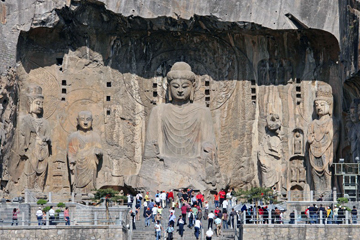
- Longmen Grottoes
Admire the spectacular World Heritage-listed Longmen Caves,comprising more than 2100 caves and 100000 Buddhist statues.Then take a visit to the White Horse Temple,China's first of Buddhist worship,wander through the narrow streets and laneways of Luoyang to see ancient horse and markets,sample a local specialty dinner.
Longmen Grottoes:one of the four largest grottoes in China. Live cultural relics lie amid green mountains and serpentine rivers. As early as 1961, Longmen Grottoes had been authorized by the central government of PRC as a key national cultural relic protection unit. It was authorized in 1982 by central government as one of the 44 National Parks of China. In 2000, it was enlisted into the List of World Heritage.
White Horse Temple: Backed by Mangshan Mountain and facing the Luohe River, White Horse Temple lies about 20 kilometers to the east of Luoyang city, Henan province. Since White Horse Temple, Buddhism monasteries in China traditionally began to be called as 'temple'. White Horse Temple as a result was ever since regarded as the cradle land of Buddhism in China. In history, highly accomplished Buddhist monks from China, even world renowned Buddhist monks from abroad used to pay visits to White Horse Temple in pursuit of Buddhism inspirations and wisdom; it was thereby also called the 'Home of Sakyamuni' or the 'Court for Ancestors'.
Day 10
Shaolin-

- Shaolin Temple
Morning drive to the legendary Shaolin Temple,which is the birthplace of China's famous martial arts-Kung Fu.You can witness thousands of monks and students practicing Kung Fu and watch a Kung Fu demonstration by some of the most gifted students before being transferred to zhengzhou airport for the flight to Shanghai.
Shaolin Temple:This temple is shrouded in legend and mystery. The origin of martial arts and kung fu is part of the mystique of Shaolin Temple and the Shaolin monks. This is probably the most famous temple in China, not only because of its long history and its role in Chinese Buddhism, but also because of its martial arts or Wushu. There is a theatre here which presents the famous Kungfu Show at 0930, 1030, 1130, 1400, 1500, and1600. It's best to get there early, as it is only a small theatre with about 200 seats.
Day 11
Shanghai-
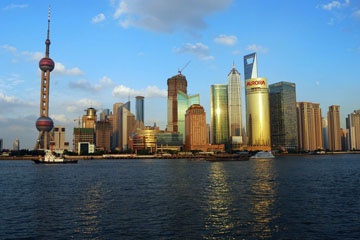
- Bund
Morning visit the Shanghai Museum and after dinner visit the Bund and enjoy the boat cruise on the Huangpu River.
Shanghai Museum: Shanghai Museum used to be near the Bund area. It is now situated in People's Square and its new buildings were built in 1996, designed by a Shanghai architect named Xing Tonghe. The new design symbolizes China's ancient understanding of the world: round sky and square earth. The museum has a circular roof and rectangular base. It stores 120,000 precious artifacts, which narrate a story of China's 5,000-year civilization.
Bund: This symbol of Shanghai is known worldwide as the ‘gallery of international architecture.’ Its assortment of buildings standing along the Huangpu River varying in height, color and architectural design make it one of the most magnificent skylines in the world.
Huangpu River:Huangpu River is a branch of the lower reaches of theYangtze River. It lies in Shanghai City, formerly known as Huangxiepu or Chunshen River. It takes its rise from theTai Lake, runs eastwards through the Dianshan Lake in Qingpu County and then flows to Minhang District in Shanghai. At the Baidu Bridge in the center of Shanghai City, Huangpu River flows together with the Wusong River (i.e. Suzhou River) and finally flows into the East China Sea.
Day 12
Shanghai-
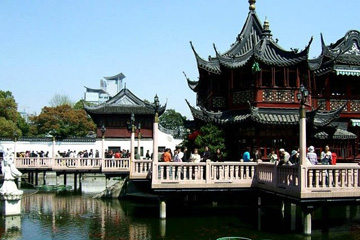
- Yuyuan Gardens
In the morning you will visit Yuyuan Garden and Jade Budda Temple.
Yuyuan Gardens: A famous garden of beauty and tranquility in the heart of Shanghai built during the Ming Dynasty 400 years ago as a son’s gift to his parents.Black tiles and white walls establish a nonchalant and simple keynote . The dainty style makes one feel comfortable, and each exquisite window lattice is telling its own story, serves the record of the past delicate life. Every piece of roof tile is passing a sort of affection of pride and memories.The entire Yuyuan Garden is bordered by the Dragon Wall.
Jade Buddha Temple:A beautiful Buddhist temple constructed in 1882 housing two spectacular, imported, jade, Burmese Buddhas.
Day 13
Shanghai your destination.After breakfast check out the hotel and transfer to the airport ,take the flight to your destination .
| Travel in party of |
Superior Class ★★★★★ |
Deluxe Class ★★★★ |
Tourist Class ★★★ |
| 2-5 persons | N | $ | $ |
| 6-9 persons | N | $ | $ |
| 10 persons & above | N | $ | $ |
| Single room Supplement | N | $ | $ |
Service included:
2 Meals as listed in the itinerary, B=breakfast; L=lunch ;
3 Personal Guide & Driver + Private car / van for Private Transfers & sightseeing
4 Hotels with breakfast(twin share bases) as listed in the itinerary .
5 Domestic flights or trains as listed in the itinerar
6 Airport Taxes: US$30for domestic,
7 Service Charge & Government Taxes .
8 Luggage Transfers between airports and hotels
9 Goverment letter for visa support
Service excluded:
2 Personal expenses, tips to the guide and driver.
Note, the price for 6-10 pax included Lunches and Dinners1 Entrance fees/
2 Meals as listed in the itinerary, B=breakfast; L=lunch ;
3 Personal Guide & Driver + Private car / van for Private Transfers & sightseeing
4 Hotels with breakfast(twin share bases) as listed in the itinerary .
5 Domestic flights or trains as listed in the itinerar
6 Airport Taxes: US$30for domestic,
7 Service Charge & Government Taxes .
8 Luggage Transfers between airports and hotels
9 Goverment letter for visa support






